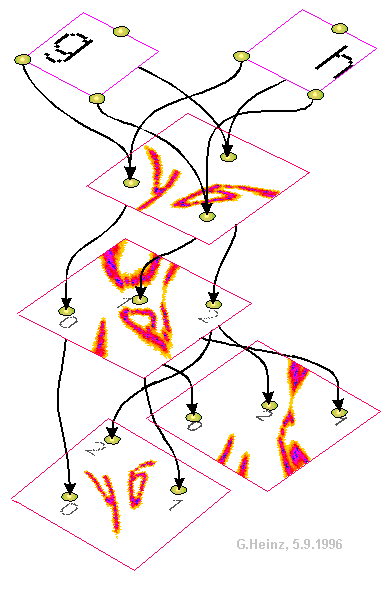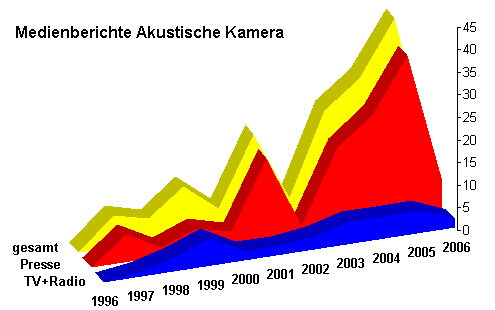

The theory of interference networks (IN) comes from the claim, that physical laws must also apply to the nervous system. So-called Artificial Neural Networks (ANNs) could not meet this requirement.
Contrary to widespread belief, that nerve conduction must be very fast to ensure the survival of a species, nerve conduction is millions of times slower than the electrical/ionic conduction of flesh. Nerves are an invention of nature, designed to conduct impulses very slowly. But why? Interference networks can provide an answer.
As luck would have it, the world's first acoustic (still) images could be developed from 1994 onwards using the simplest software for the reconstruction of neural data (Bio-Interface alias PSI-Tools alias NoiseImage).

Do we know anything about information processing of our brain? Why is it for us not able, to add millions of binary numbers within a second like a computer? And, on the other hand, why can the brain solve much more complex tasks, where computers have no chance?
If we think about anything, we solve the details not with computer code - we solve any task with imagination, not abstractly: We think in (mirrored) images! Or as C.S. Peirce (1837-1914) 1902 stated: "All thought is in signs". We don't even solve arithmetic problems abstractly, but rather with our imagination.
Even the unit of measurement of (first) computer science - the bit - doesn't exist in this second informatics. Pulses are not bits! Only where a pulse meets its twins, its predecessors, or its successors, does a blurred or sharp pixel emerge, and information is created.
Translated into projective mappings, the bit can only be characterized by the sharpness of the mapping: The sharper it is, the more bits can be transferred between the original and the image. The fuzzier it is, the more error-tolerant the projection is.
Why is information processing in nerve systems so far away from that of computers? Does the brain use a second information science, we know nothing about?
Compared to computers, our brain functions very differently. While in computers, information is exchanged from gate to gate in a targeted manner, in IN, information is only created at points of simultaneity.
The nervous system is full of mirror-inverted maps. What is the reason for this? And why did Lashley's rat experiments show, that information is stored holographically in the brain?
Why did evolution develop very slow delay lines in nerves? We know that body tissue conducts electrical current (ionic current) millions of times faster.
And last but not least: Why does the nervous system use extremely sharp impulses to transmit information? They only excite a neuron where many pulses meet at exactly the same time.
Computers can't do anything with pulses, they use static binary levels ("HIGH" and "LOW") and clocks (Takte).
If we think about projections in time-delaying systems, for example about optical lense systems, we realize, that forward-running time (without tricks) can only produce mirror-inverted maps.
A look at some neuroanatomy textbooks showed the autor 1992, that the nervous system is full of them. It was the motivation to make 1992 the thumb experiment (german, english) and to write 1993 the book "Neuronale Interferenzen" (german). The 1990s brought simulations of pulse projections.
Acoustic photo- and cinematography (Acoustic Camera) became the first application of a simplast interference network.
The page in detail is not concerned with Artificial Neural Nets (ANN) or learning rules, nor with synaptic properties of nerves. These topic areas are sufficiently investigated. If we talk about delaying, interference networks (IN), we talk only about delay properties of clockless (taktfreie) networks using pulse waves, about wave interference in time-delaying networks
Notes:
The site contains with 4 GB over 5,300 files in over 330 directories, and its structure has evolved over 30 years. Please save all links important to your work, otherwise you may not be able to find them again!
The circuits shown here as "wave interference networks" are not electrical networks, but rather nerve-like networks with extremely low conduction velocities. All channels, fields or rooms delay the pulses! The electrical node abstraction of a line is not valid here!
Find here a further introduction and a rough overview in (german) (english).
(See also the Publications Directory)

In 1994 started a new age, when we got the first acoustic still-images with an EEG-datarecorder and the interference-net simulator "Bio-Interface", written by Sabine Höfs. It became the age of Acoustic Photo- and Cinematography, the age of acoustic images and films. Our first and most important partner was the german car industry. Porsche promoted us with lots of critical first tasks. And they ordered the first produced Acoustic Camera in the world - two weeks before 9/11/2001 for nearly 200,000 DM. Today it is a mass-market. Although it was patented in 30 countries, dozens of companies copied the idea. Hundreds of acousticians worldwide use Acoustic Cameras today.


Mail to info@gheinz.de
Visitors since Dec. 2021: